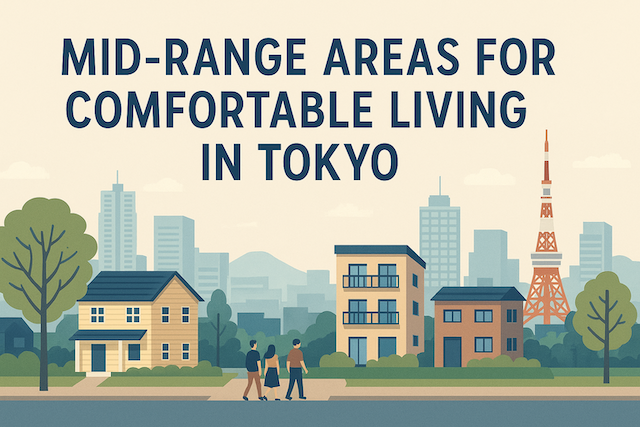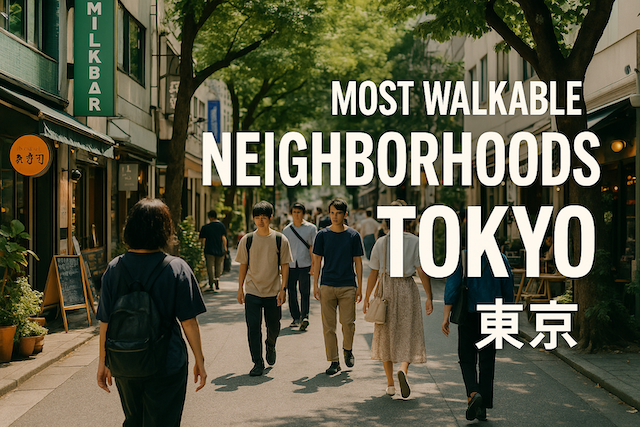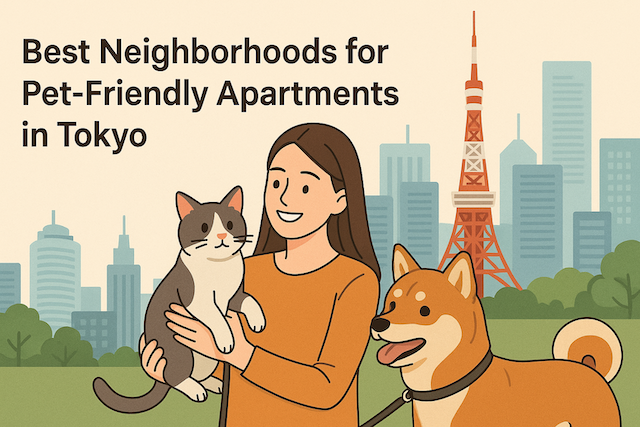Mid-Range Areas for Comfortable Living in Tokyo
Finding a home in Tokyo can be challenging, especially when balancing cost, comfort, and convenience. While some neighborhoods are known for luxury and others for affordability, there is a wide middle ground — areas that offer a high quality of life without breaking the bank. These mid-range neighborhoods provide good access to central Tokyo, comfortable living conditions, and a balanced lifestyle suitable for families, professionals, and expats.
In this article, we’ll explore the best mid-range areas to live in Tokyo, focusing on rent levels, transportation, atmosphere, and nearby amenities.
Understanding “Mid-Range” Living in Tokyo
Before diving into specific areas, it’s important to define what “mid-range” means in Tokyo. Rent prices can vary greatly depending on proximity to the Yamanote Line, the number of train transfers required to reach major stations, and the general popularity of the neighborhood.
As of 2025, the average rent for mid-range living typically means:
-
Studio (1R or 1K): ¥80,000–¥110,000 per month
-
1LDK or 2K units: ¥120,000–¥160,000 per month
-
2LDK family-type apartments: ¥170,000–¥230,000 per month
These neighborhoods are neither as expensive as Shibuya or Azabu-Juban, nor as cheap as Tokyo’s outskirts like Hachioji or Adachi. Instead, they strike a perfect balance — offering comfort, decent space, and a lively yet calm environment.
Kichijoji: Balanced Lifestyle with Green Spaces
Area: Musashino City (Western Tokyo)
Average Rent: Moderate (¥100,000–¥160,000 for 1LDK)
Kichijoji consistently ranks among Tokyo’s most desirable areas for living. It offers an incredible mix of urban convenience and natural beauty, mainly thanks to the famous Inokashira Park, which serves as the neighborhood’s heart. Residents can enjoy weekend walks, picnics, and rowing on the park’s lake — a rare treat in busy Tokyo.
The area also features a vibrant shopping district around Sun Road and Harmonica Yokocho, filled with cafés, vintage stores, and izakayas. The overall vibe is relaxed yet trendy, making Kichijoji popular among young professionals, families, and creatives.
Transportation:
-
JR Chuo Line (15 min to Shinjuku)
-
Keio Inokashira Line (20 min to Shibuya)
Why it’s mid-range:
Kichijoji offers the atmosphere of a high-end suburb but at lower rent than central Tokyo. You pay for lifestyle and access, not luxury.
Nakano: Urban Convenience with Local Flavor
Area: Nakano Ward
Average Rent: ¥90,000–¥130,000 (1K to 1LDK)
Nakano is one of Tokyo’s most dynamic mid-range neighborhoods, located just one stop west of Shinjuku. It’s famous for Nakano Broadway, a shopping complex that attracts anime, manga, and collectible enthusiasts. However, beyond the otaku culture, Nakano offers a cozy, residential environment with a strong local community.
The area’s small streets are lined with ramen shops, sento (public baths), and tiny bars. It feels more grounded and less polished than neighboring Koenji or Ogikubo, yet it’s perfectly connected to the city center.
Transportation:
-
JR Chuo Line (5 min to Shinjuku)
-
Tokyo Metro Tozai Line
Why it’s mid-range:
You’re close to central Tokyo without central prices. The apartments are compact but well-built, and the neighborhood energy is vibrant yet friendly.
Koenji: Creative and Comfortable
Area: Suginami Ward
Average Rent: ¥85,000–¥125,000 (1K–1LDK)
Koenji is often called the hipster capital of Tokyo, but beyond its reputation for vintage shops and live music, it’s also a very livable area. The residential streets are quiet, and there’s a strong sense of community. Rent remains moderate compared to trendier neighbors like Kichijoji or Shimokitazawa.
The area has numerous small parks, affordable restaurants, and supermarkets, making it suitable for young couples and professionals. Koenji’s creative vibe gives it a unique personality without compromising daily comfort.
Transportation:
-
JR Chuo Line (8 min to Shinjuku)
-
Marunouchi Line (via nearby Shin-Koenji)
Why it’s mid-range:
Affordable, well-connected, and full of local charm — ideal for those who want culture without chaos.
Meguro: Quiet Elegance Near the City Center
Area: Meguro Ward
Average Rent: ¥110,000–¥160,000 (1K–1LDK)
Meguro strikes an excellent balance between prestige and affordability. While parts of the ward, like Daikanyama, are expensive, areas near Meguro Station and Gakugei-Daigaku offer moderate rents and a refined living environment.
Meguro is known for its beautiful river views, cherry blossoms, and peaceful atmosphere. It’s a preferred choice for professionals working in central Tokyo who value both quietness and accessibility.
Transportation:
-
JR Yamanote Line
-
Tokyu Meguro Line
-
Namboku Line
Why it’s mid-range:
Close to major business hubs like Shibuya and Ebisu, yet more relaxed and reasonably priced than Minato or Shinjuku.
Nishi-Ogikubo: Family-Friendly and Laid-Back
Area: Suginami Ward
Average Rent: ¥100,000–¥140,000 (1LDK–2LDK)
Often overshadowed by nearby Kichijoji and Koenji, Nishi-Ogikubo quietly offers a very comfortable residential experience. It’s known for its antique shops, cozy cafés, and family-run restaurants. The streets are calm, safe, and filled with greenery.
The area appeals particularly to small families and artists who appreciate slower-paced living while maintaining convenient access to central Tokyo.
Transportation:
-
JR Chuo Line (15 min to Shinjuku)
Why it’s mid-range:
More spacious apartments than inner-city areas at reasonable prices, perfect for families.
Komazawa-Daigaku: Suburban Comfort with Easy Access
Area: Setagaya Ward
Average Rent: ¥100,000–¥140,000 (1LDK–2LDK)
Komazawa-Daigaku is a calm and clean neighborhood located along the Den-en-toshi Line, offering direct access to Shibuya in under 15 minutes. The highlight of this area is Komazawa Olympic Park, a vast green space ideal for jogging, cycling, and weekend picnics.
The streets are lined with bakeries, pet-friendly cafés, and local grocery stores, making daily life convenient and relaxing. It’s a hidden gem for those who want suburban tranquility without giving up city access.
Transportation:
-
Tokyu Den-en-toshi Line (12 min to Shibuya)
Why it’s mid-range:
Spacious, quiet, and family-friendly, yet close enough to commute comfortably to central Tokyo.
Kinshicho: Affordable Comfort with Urban Energy
Area: Sumida Ward
Average Rent: ¥90,000–¥130,000 (1K–1LDK)
Located east of Tokyo, Kinshicho offers excellent value for money. It’s one of the few neighborhoods where you can still find affordable mid-sized apartments close to central Tokyo. The area has large shopping complexes like ArcaKit Kinshicho and Olinas Mall, as well as easy access to Tokyo Skytree and Asakusa.
While it has a busy station area, the residential zones behind the main streets are peaceful and safe. It’s also convenient for commuting to both Tokyo Station and Shibuya.
Transportation:
-
JR Sobu Line
-
Hanzomon Line
Why it’s mid-range:
Affordable with big-city amenities and good access to multiple parts of Tokyo.
Oimachi: Balanced Urban Hub in South Tokyo
Area: Shinagawa Ward
Average Rent: ¥100,000–¥140,000 (1LDK–2LDK)
Oimachi is a transportation hub connecting central Tokyo, Yokohama, and Haneda Airport. Despite its strategic location, the area remains relatively affordable and less crowded than nearby Shinagawa.
It offers a mix of modern apartments, shopping centers, and quiet backstreets, appealing to both professionals and small families. With the bay area nearby, residents also enjoy fresh air and open spaces.
Transportation:
-
JR Keihin-Tohoku Line
-
Tokyu Oimachi Line
-
Rinkai Line
Why it’s mid-range:
Ideal for frequent travelers or office workers needing access to both Tokyo and Yokohama.
Kamata: Convenient and Budget-Friendly
Area: Ota Ward
Average Rent: ¥85,000–¥120,000 (1K–1LDK)
Kamata is an underrated residential area near Haneda Airport. It’s lively, filled with restaurants, shopping arcades, and public baths, offering an authentic Tokyo atmosphere. The area has improved significantly with urban redevelopment projects, making it more attractive to young professionals and expats.
Transportation:
-
JR Keihin-Tohoku Line
-
Tokyu Ikegami Line
-
Keikyu Line (to Haneda Airport)
Why it’s mid-range:
Good transport, affordable housing, and an authentic Tokyo feel — great for those who value practicality.
Summary: Choosing the Right Mid-Range Area for You
Tokyo’s mid-range neighborhoods prove that you don’t need to sacrifice comfort or location to live well. Whether you prefer the greenery of Kichijoji, the creative culture of Koenji, or the urban convenience of Meguro, there’s a balance for every lifestyle.
Quick Summary Table:
| Area | Ward | Character | Commute to Shinjuku/Shibuya | Rent Range (1LDK) |
|---|---|---|---|---|
| Kichijoji | Musashino | Green, lively | 15–20 min | ¥120k–¥160k |
| Nakano | Nakano | Central, local | 5–10 min | ¥100k–¥130k |
| Koenji | Suginami | Creative, relaxed | 8–10 min | ¥90k–¥120k |
| Meguro | Meguro | Elegant, peaceful | 10–15 min | ¥130k–¥160k |
| Nishi-Ogikubo | Suginami | Family-friendly | 15 min | ¥110k–¥140k |
| Komazawa-Daigaku | Setagaya | Suburban comfort | 12 min | ¥100k–¥140k |
| Kinshicho | Sumida | Convenient, vibrant | 15–20 min | ¥90k–¥130k |
| Oimachi | Shinagawa | Balanced, modern | 15–20 min | ¥100k–¥140k |
| Kamata | Ota | Local, practical | 20–25 min | ¥85k–¥120k |
Final Thoughts
Living in Tokyo doesn’t always mean choosing between sky-high rent and long commutes. The city’s mid-range areas offer the best of both worlds — reasonable costs, safety, and convenient transport links. Whether you’re a foreign resident, digital nomad, or Japanese professional, these neighborhoods provide a solid foundation for a comfortable and balanced lifestyle in one of the world’s most dynamic cities.
FAQs
What does “mid-range” living in Tokyo mean?
Mid-range living refers to neighborhoods that balance price, comfort, and access. Rents are typically moderate compared to prime central districts but higher than far-out suburbs. Expect reasonable commutes, everyday conveniences (supermarkets, clinics, cafés), and a calm residential feel without the high-end price tag associated with luxury hubs like Azabu-Juban or prime Shibuya.
How much rent should I budget for mid-range areas?
Budgets vary by unit size and age of the building. As a rough guide, studios (1R/1K) often fall in the ¥80,000–¥110,000 range, 1LDK/2K in the ¥120,000–¥160,000 range, and 2LDK in the ¥170,000–¥230,000 range. Newer or renovated units near major stations trend higher; older walk-up apartments may be notably cheaper.
Which Tokyo areas are considered mid-range yet comfortable?
Popular choices include Kichijoji, Nakano, Koenji, Meguro, Nishi-Ogikubo, Komazawa-Daigaku, Kinshicho, Oimachi, and Kamata. Each offers a distinct mix of transport access, local shops, parks, and community vibe, making them appealing to professionals, couples, and small families seeking balance over prestige or rock-bottom pricing.
How long are typical commutes from these neighborhoods?
Most listed areas provide direct or one-transfer access to Shinjuku, Shibuya, or Tokyo Station in roughly 10–30 minutes. For example, Nakano and Koenji are minutes from Shinjuku via the Chuo Line, while Komazawa-Daigaku reaches Shibuya quickly on the Den-en-toshi Line. Commute time can vary by rush-hour crowding and transfer waits.
Are these areas suitable for families?
Yes. Locations like Nishi-Ogikubo, Kichijoji, and Komazawa-Daigaku are popular with families due to quieter streets, parks (e.g., Inokashira Park, Komazawa Olympic Park), and access to schools and clinics. Look for 2LDK units or larger, proximity to playgrounds, wide sidewalks, and safe cycling routes for a family-friendly setup.
What should I expect for upfront move-in costs?
Initial costs can equal 3–5 months of rent, sometimes more. Common line items include: deposit (shikikin), key money (reikin, often zero to one month), agency fee (usually one month plus tax), guarantor company fee, lock exchange, and first month’s rent. “No key money” campaigns and furnished rentals can reduce upfront expenses.
Do I need a guarantor, and what if I don’t have one?
Most leases require either a personal guarantor in Japan or a guarantor company (hoshōgaisha). If you lack a local guarantor, the company option is standard. Expect a one-time fee (often 30–100% of monthly rent) and an annual renewal fee. Some foreigner-friendly agencies bundle guarantor services.
Are pets allowed in mid-range apartments?
Pet policies vary by building. “Pet-friendly” (ペット可) listings exist in most mid-range areas but may charge higher deposits or pet cleaning fees. Komazawa-Daigaku and Kichijoji, with their parks and pet-friendly cafés, are particularly convenient if you own a dog. Always confirm restrictions on size, breed, and number.
Is English support available for contracts and maintenance?
English-speaking agents and management companies are increasingly common in mid-range districts with international residents (e.g., Meguro, Nakano). However, not every landlord or building manager offers English support. To avoid misunderstandings, ask for bilingual contracts, clarify repair procedures, and consider an agent who handles post-move support.
How do building type and age affect comfort and noise?
Newer reinforced concrete (RC) buildings generally offer better sound insulation than older wooden or lightweight structures. Double-glazed windows help on train-adjacent streets. If noise is a concern, prioritize top-floor corner units, avoid rooms facing busy roads, and visit at different times (morning/evening) to test ambient noise.
What about earthquake safety and building standards?
Look for properties built or renovated under newer earthquake codes (1981 and especially after 2000 standards). RC or steel-reinforced structures, secure cabinetry, and building emergency plans add peace of mind. Ask the agent about seismic retrofits, evacuation routes, and whether the building keeps emergency water and supplies.
How can I compare value between neighborhoods?
Assess total living value, not just rent: commute time and cost, grocery options, healthcare access, daycare/schools, noise levels, and local green space. A slightly higher rent in a walkable area with fewer transfers can save money and stress compared to a cheaper unit with long, crowded commutes and limited amenities.
Are furnished or short-term rentals available?
Yes, but furnished and short-term units usually command a premium. In mid-range areas, you’ll find corporate or serviced apartments, monthly mansions, and select furnished listings through international agencies. If staying long-term, unfurnished units plus affordable secondhand furniture often yield the best overall value.
What utilities and monthly extras should I plan for?
Beyond rent, budget for utilities (electricity, gas, water), internet, and possibly building management fees. In winter, heating costs (especially in older units) can be significant; in summer, air conditioning adds to the bill. Some buildings include internet in the management fee—confirm before signing.
When is the best time of year to search?
Peak seasons (February–April and September) see fast-moving inventory and stiffer competition. Searching slightly off-peak can improve negotiating leverage or access to move-in incentives. If you must move in peak months, prepare documents early, pre-approve with a guarantor company, and be ready to apply immediately after viewing.
Any tips for viewing and applying efficiently?
Bring ID, proof of income, residence card (if applicable), and employer details. Prepare a short self-introduction for the landlord. Arrive with a checklist: noise, insulation, storage, sunlight, water pressure, outlets, cellular reception, bicycle parking, trash rules, and disaster kits. If the unit fits, apply the same day.
How do these areas differ in lifestyle vibe?
Kichijoji blends park-side leisure with boutique shopping; Nakano offers local energy and quick city access; Koenji highlights vintage culture and indie venues; Meguro favors quiet elegance; Nishi-Ogikubo feels family-first and artsy; Komazawa-Daigaku suits outdoor lifestyles; Kinshicho is urban and convenient; Oimachi and Kamata provide transport hubs with practical amenities.
Bottom line: who should pick mid-range areas?
Choose mid-range neighborhoods if you want a balanced life—solid commutes, everyday conveniences, and a comfortable home without premium-center rents. They’re ideal for professionals, couples, and small families who value livability and community vibe over high-end branding or ultra-low pricing at the city’s edge.



![Where to Live in Tokyo for Families with Kids [2025–2026 Guide]](https://tokyorelocationguide.com/wp-content/uploads/2025/10/ChatGPT-Image-Oct-17-2025-03_55_59-PM.png)


![Where to Live in Tokyo for Expats [2025-2026 Guide]](https://tokyorelocationguide.com/wp-content/uploads/2025/10/ChatGPT-Image-Oct-17-2025-03_50_34-PM.png)
